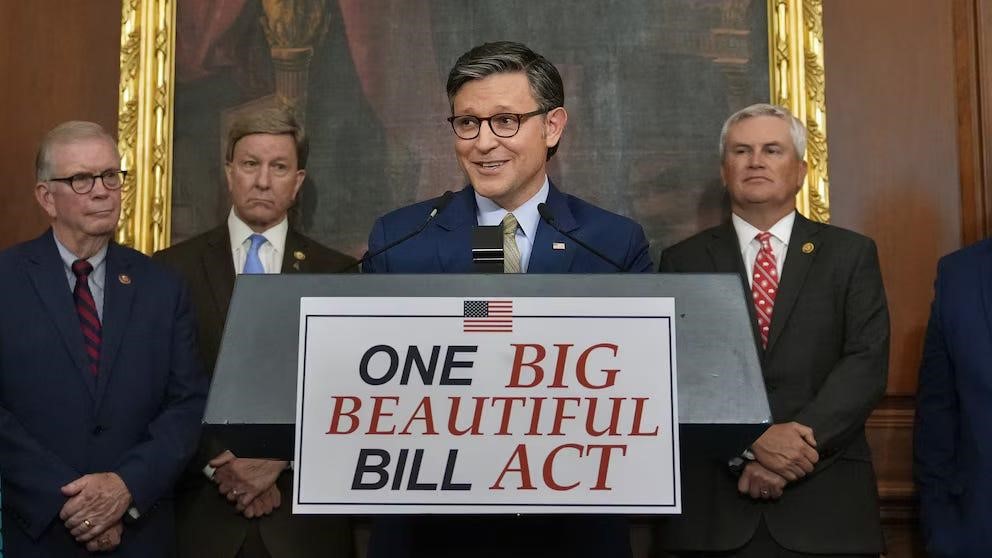Trump’s Big Beautiful Bill Raises Fiscal Concerns
Trump’s Big Beautiful Bill Raises Fiscal Concerns
Syllabus:
GS-3: Government Budgeting
Focus: The One Big Beautiful Bill Act of 2025 (OBBBA), passed by the US House of Representatives, is a major legislative initiative by President Donald Trump. Combining tax cuts, spending hikes, and a raised debt ceiling, it now awaits Senate approval, amid economic and redistributive concerns from economists and legislators alike.
Background and Legislative Process:
Trump’s Vision in a Single Law
- The OBBBA encapsulates President Donald Trump’s second-term agenda, bundling key campaign promises into a single legislative proposal with a beautiful figure of fiscal reform. This big comprehensive bill aims to reshape America’s economic landscape.
- Key elements like tax cuts and increased defense spending require Congressional approval, making this bill a central piece of Trump’s policy agenda. The bill, often referred to as the “big letter” of Trump’s presidency, is set to make significant changes.
Passage and Current Status
- Passed by the House of Representatives; now pending US Senate deliberation.
- May undergo amendments and negotiations between both chambers before reaching the President’s desk for final approval.
- Reflects the Republican Party’s push to implement core economic and security policies before the next elections. The bill, available as a big pdf document, outlines extensive changes to the current system.
Core Provisions of the OBBB Act:
Tax Cuts for Middle Class and Wealthy
- Makes 2017 tax cuts permanent, benefiting income and estate tax payers.
- Introduces new tax cuts on tips, overtime, and social security income.
- Expected to cut taxes for Americans earning $30,000 to $80,000 by 15% next year, with additional income tax cuts 2025 planned.
- Includes estate tax cuts and changes to the Salt deduction, as part of the broader tax reform package.
- Recent standard deduction news suggests potential increases to benefit middle-income taxpayers.
- The bill also addresses the clean energy incentives phase-out, potentially affecting renewable energy investments.
Increased Public Spending
- Major investments in border security spending and military modernization.
- Aims to boost national defense capabilities and reduce illegal immigration.
- Allocates funds for border wall construction and increased Immigration and Customs Enforcement funding to support deportation operations.
Administrative Reforms and Debt Ceiling
- Targets “waste, fraud, and abuse” in government programs.
- Seeks to raise the USA debt ceiling, enabling further borrowing to meet fiscal obligations. This includes provision for making payment in future, ensuring the government can meet its financial commitments.
- Raising the ceiling is crucial, as the US government risks default without it, potentially impacting the beautiful ceiling of economic stability.
Economic and Fiscal Concerns:
Growing Budget Deficit
- Tax cuts and spending hikes will significantly widen the fiscal deficit.
- The US federal deficit was already at 6.4% of GDP in 2024 (~$1.9 trillion). To put this in perspective, one trillion is equal to a thousand billion dollars, highlighting the magnitude of the deficit.
- Economists warn of an unsustainable path, projecting deficits of up to 9% of GDP by 2035, raising serious fiscal deficit concerns.
Rising National Debt
- The debt-to-GDP ratio has surged past 120%, with national debt projections indicating it could hit 200% in the next decade.
- Charted trends reflect a trajectory similar to World War-era debt levels.
- Growing debt erodes investor confidence, leading to higher borrowing costs and impacting bond yields. This situation reminds us that money is not permanent quotes often ring true in economic cycles.
Credit Rating Downgrades
- Moody’s recently stripped US debt of its AAA rating, following Fitch and S&P earlier.
- These credit ratings downgrades increase interest rates on US Treasury bonds, affecting government borrowing and private lending rates.
Redistributive Implications and Equity Debate:
A Shift from Poor to Rich?
- Critics like Justin Wolfers label it an “anti-Robin Hood” bill, echoing poor rich quotes about wealth redistribution.
- Provides tax relief to the wealthy, while reducing government transfers to low-income Americans.
- Introduces work requirements for certain social programs, potentially affecting access to benefits. This change may alter the safety net standard size for many Americans.
Congressional Budget Office (CBO) Analysis
- Congressional Budget Office analysis, conducted by the government’s primary analysis office, projects household resources will decline by 21% for the poorest decile by 2027, due to cuts in Medicaid and SNAP.
- Medicaid cuts and Snap cuts are expected to significantly impact low-income households.
- Meanwhile, high earners will see a 4% increase in resources by 2027.
- By 2033, resource inequality will further deepen under current provisions.
Strategic and Political Implications:
Impact on Electoral Prospects
- Republicans risk electoral backlash if voters perceive the bill as favoring the rich.
- While aimed at economic stimulus, the unbalanced benefits may alienate middle-class and lower-income voters.
Long-Term Risks to Fiscal Sovereignty
- Experts, including Federal Reserve Chair Jay Powell, caution against mounting debt burdens.
- Rising interest payments may crowd out essential government spending.
- Future administrations may face constrained fiscal options and lower public trust in governance.
Macroeconomic Implications
- The bill’s macroeconomic implications extend beyond immediate fiscal effects, potentially influencing long-term economic growth, inflation, and international competitiveness.
- Economists debate the balance between short-term stimulus and long-term fiscal sustainability. Some argue that the economic pressure created by this bill could be likened to state Boyle’s law, where increasing one variable (spending) while constraining another (revenue) leads to increased pressure on the system.
Conclusion:
The One Big Beautiful Bill is an ambitious legislative move by President Trump, aiming to fulfill campaign promises. However, its fiscal indiscipline and uneven redistributive aspects raise alarms. As the US navigates rising deficits and debt, the bill could reshape not just economic policy, but also electoral and global fiscal dynamics. The proposed standard deduction increase and other measures in this budget tax overhaul will have far-reaching implications for US government finances and the broader economy. While the bill promises a beautiful big house image for the American economy, critics argue it may be building on an unstable foundation.
Source: IE






